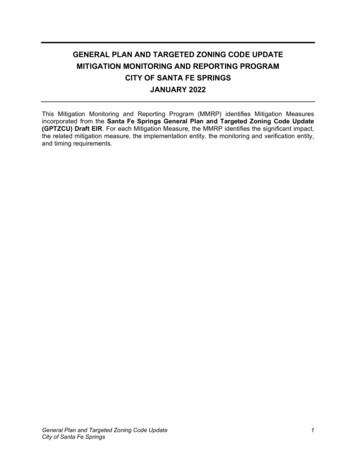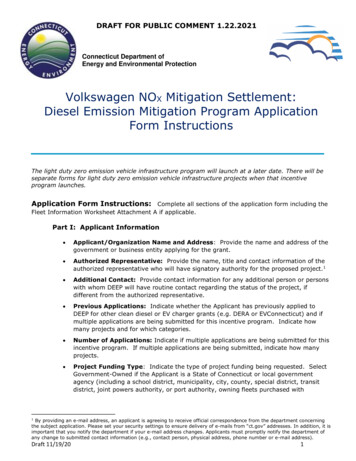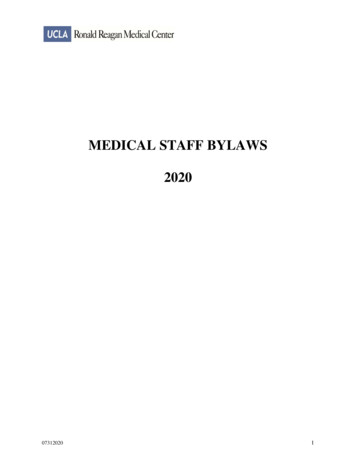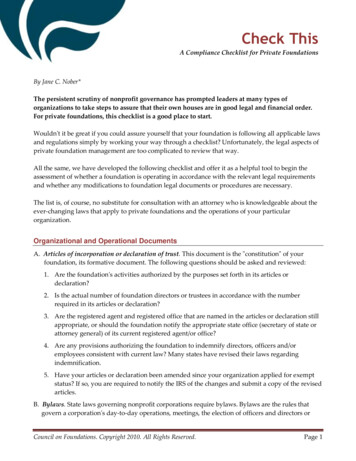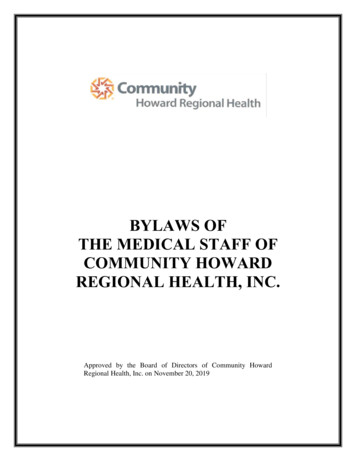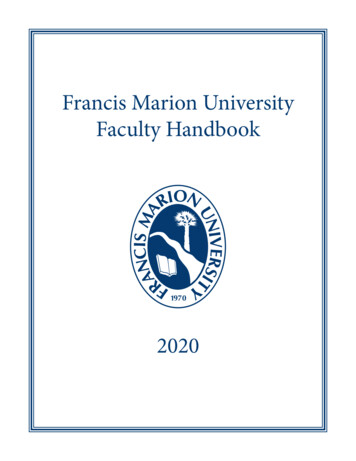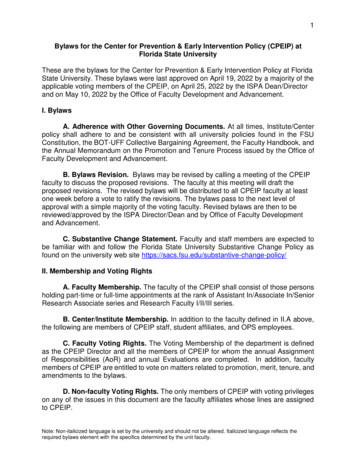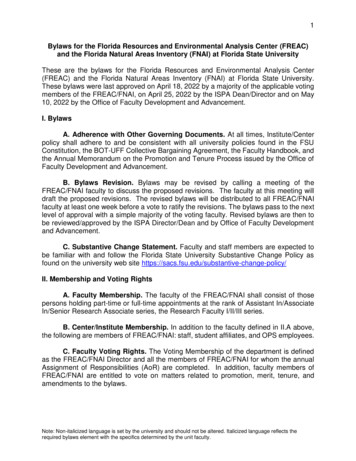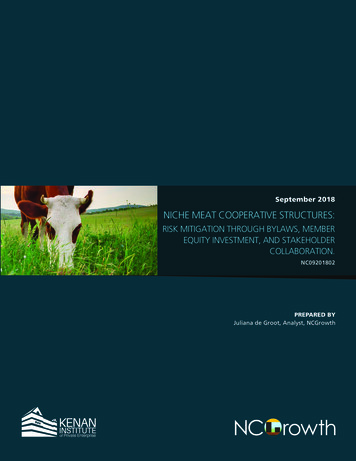
Transcription
September 2018NICHE MEAT COOPERATIVE STRUCTURES:RISK MITIGATION THROUGH BYLAWS, MEMBEREQUITY INVESTMENT, AND STAKEHOLDERCOLLABORATION.NC09201802PREPARED BYJuliana de Groot, Analyst, NCGrowth
People Business CommunityNCGrowth is an EDA University Center housed at UNC Chapel Hill’s KenanInstitute for Private Enterprise that helps businesses and communities creategood jobs and equitable opportunities through applied research and technicalassistance. With a passionate staff and a dynamic pool of graduate studentanalysts, we partner with businesses, communities, governments andother organizations to tackle outcome-based economic development andentrepreneurship projects. NCGrowth is funded by the Frank Hawkins KenanInstitute of Private Enterprise, US Economic Development Administration,GoldenLEAF Foundation, US Department of Agriculture, and the Z SmithReynolds Foundation.www.ncgrowth.unc.edu NCGrowth@unc.edu
TABLE OF CONTENTSINTRODUCTION. 1PROJECT OVERVIEW 1AGRICULTURE COOPERATIVES 1NICHE MEAT PRODUCTION IN NORTH CAROLINA 1BEST PRACTICES. 2OPERATIONS MANAGER 2OPERATIONS DOCUMENTS 2POOLING SERVICES AND PRODUCTS 3EQUITY STRUCTURE 4CASE STUDIES: . 4ORGANIC VALLEY. 4GRASS ROOTS FARMERS’ COOPERATIVE 5ISLAND GROWN FARMERS COOPERATIVE 6CONCLUSION. 7RESOURCES. 8APPENDIX. 9
OLDER ADULTS AND THE CHALLENGE OF AGING IN PLACE KENAN INSTITUTE CONFERENCE PROCEEDINGSINTRODUCTIONPROJECT OVERVIEWNC Growth analyst Juliana de Groot worked with NC Choices and NC NHGA to develop abest-practices report for niche meat cooperatives, which focuses on policies and proceduresfor growing and maintaining young cooperative businesses focused on pasture raisedmeat and collaboration between various stakeholders. Information from the report hasbeen gathered from interviews with cooperative developers, consultants, managers andcooperative board members throughout the country.Agricultural AGRICULTURE COOPERATIVEScooperatives Many small scale agricultural cooperatives face similar problems during growth--theseallow small scale usually center on management, operations, and marketing. Niche meat cooperatives faceand larger scale uniquely specific issues due to smaller markets, processor logistics, and competition fromfarmers, producers large-scale conventional producers. Agricultural cooperatives allow small scale and largerand processors to scale farmers, producers and processors to strategically pool resources and capital in waysstrategically pool that allow them to capitalize on their collaboration to collectively foster opportunity andresources and capital success. For regional or niche product farmers, cooperatives can provide services thatin ways that allow allow small and local businesses to thrive. Small scale meat cooperatives can solve logisticalthem to capitalize on challenges that individual farmers may face, such as transportation to slaughterhouses,their collaboration quality processing, feed and equipment purchasing, start-up cash flow for new farmers,to collectively foster education and consulting, marketing and sales services, among others. Cooperatives areopportunity and unique in each application, however, there are several aspects that might allow small meatsuccess. producers to capitalize on the services provided; pooling products, opportunities to buildequity and hired management.NICHE MEAT PRODUCTION IN NORTH CAROLINALarge scale conventional meat production in North Carolina uses contained animal feedingoperations (CAFOs) for production (S Wing & Wolf, 2000). Many family-owned livestockfarms have transitioned to contracts with large corporations, and the animal waste fromthese operations present dire environmental justice and health equity issues, centered on1
NCGROWTH NICHE MEAT COOPERATIVE STRUCTURESlow-resource, African American and Native American neighbors whose land and townsare inundated with hog waste spray and pollution (Steve Wing & Johnston, 2014). Pastureraised animal production presents an alternative to the environmental degradation andpublic health crisis presented by conventional facilities, and provides ethical local meatproducts for consumption. Small farmers provide their regions with economic prosperity,which is further enhanced by collaboration between farmers in agricultural cooperatives(Gwin, Thiboumery, & Stillman, 2013). These business ventures invest in economicdevelopment for rural communities who face economic disempowerment and highrates of poor health outcomes (Gwin et al., 2013). In order for cooperatives to thrive,local stakeholder involvement is crucial. Stakeholders include cooperative developmentinstitutions, local agriculture extension offices, local governments, and university initiativesfocused on local economic development.BEST PRACTICESFor most cooperative businesses, there is much variation between structure, organization,size and governance, however there are several best practices specifically for niche meatproducer coops that are worth mentioning. First, hiring an operations manager who is notprimarily concerned with running their own business, but focused mainly on the health ofthe cooperative. Second, developing flexible guiding documents to organize and managethe cooperative is imperative. Bylaws are important, however sometimes not necessary forthe day-to-day management of the cooperative. Third, cooperatives can remain flexibleand nimble by pooling products and services into different categories—this allows them tostratify products based on quality, seasonality, quantity, or other factors that are importantfor their business needs.OPERATIONS MANAGERHiring outside operations managers has been instrumental to the success of small nichemeat cooperative businesses. For cooperatives such as Grass Roots Farmers Coop, andIsland Grown Farmers Coop, this has allowed the farmers served by the coop to focus theirenergy on farming, while ensuring sustainable cooperative operations. Tall Grass PrairieCoop was an example of a small niche-meat producer and marketing cooperative, whodid not hire outside manager, and instead operated on a volunteer basis from their existingpool of members—and lists this as one of the important factors that led to the end oftheir cooperative (Wilson, 2001). An organized and proficient operations manager handlesthe day to day tasks of operating the cooperative business, and is an employee of thecooperative. In some cases they are also coop members, but there is no strict guidelines asto the management organization, and each cooperative can decide what is best for theirbusiness.OPERATIONS DOCUMENTSGuiding documents that aid in the day-to-day operations of cooperatives are incredibly2Pasture-raised animalproduction presentsan alternative tothe environmentaldegradation andpublic healthcrisis presentedby conventionalfacilities, andprovides ethical localmeat products forconsumption.
NCGROWTH NICHE MEAT COOPERATIVE STRUCTURESimportant. Developing these documents, including detailed notes and legacydocumentation on different positions, procedures, commitments and contracts istantamount to a successful cooperative. This is especially true for cooperatives who areundergoing transition periods and periods of growth and development. Grass RootsFarmers Cooperative uses a lengthy operations document to manage daily operations andmaintain animal husbandry standards among their divers membership base.POOLING SERVICES AND PRODUCTSPooling services and products is a strategy that many cooperatives use to manage thediffering needs of their members, while retaining strong relationships with customers. Forinstance, if a cooperative is pulling together meat from 15 different farmers there couldbe large gaps in quality. Pooling products of similar qualities can allow the cooperativeto meet customer expectations (on price or quality) while also continuing to provide anavenue for marketing pasture raised meats for small farmers who might not otherwisebe able to reach a sustainable customer base. In addition to the customer benefits forpooling, the cooperative could provide different services for each pool, depending onthe needs of the members in each respective pool. This could be technical assistance infarming practices, certification assistance, or assistance in starting their business.Figure 1.1 Example of Pooling Structure3
NCGROWTH NICHE MEAT COOPERATIVE STRUCTURESEQUITY STRUCTUREDeveloping a sustainable equity structure has several important benefits for farmers andtheir cooperatives. First, through monetary investments, members make a commitment tothe success of the cooperative, and the cooperative is able to utilize that money to investin infrastructure and supplies. Second, there is a benefit to the farmer’s themselves, asthey are able to build equity in a collective business, outside of their own, adding to theirpersonal financial health.CASE alleyNationwide,based inWisconsinMarketing2,044932Feed program,education,mar-keting,Dairy, Beef,5.5% buy-in ofPork, Eggs, Pro- yearly sales toduceOV, 8% re-turnsevery year.Grass RootsFarmers'CoopArkansasMarketing157 employees:General manager, operations,live-stock technical assistant,invento-ry, communica-tions,accountingProvide startChicken, Turup fee for newkey, Pork, Beeffarms, marketingunder one label,processing,dis-tribution,feed program,no ocessing658 full timeem-ployees,1 part time: 2on MSU, 6 atcutting plant, 1bookkeeperSlaughter,pro-cessing, cut& wrap, retailpack-agingbuy in 5%of fees paidto coop forser-vices/use,some membershave nearly 30,000 inequity.Beef, Pork,LambORGANIC VALLEYOrganic Valley is an organic dairy marketing cooperative founded in Wisconsin in 1988as the Cooperative Regions of Organic Producer Pools. It now consists of 2,000 memberfarms across the country. For this project we talked with Gerry Cohn, the Southern PoolRegional Manager who manages the sales and services provided to the southern dairyfarms in the cooperative. In addition to dairy, OC sells produce, beef and pork under theOrganic Prairie label. OC processes, markets and sells products under its own label, so the2,000 farms are the producer, while OV manages the rest. Half of their members aresmall Mennonite and Amish farms--which are close to the route to larger farms.4EquityStructureCoop
NCGROWTH NICHE MEAT COOPERATIVE STRUCTURESBylaws are not the most important document in terms of managing the cooperative, andthey regularly return to their member agreement when questions arise. The cooperative isstructured such that members have the opportunity to be on advisory boards, and workon different initiatives of the cooperative in addition to having the opportunity to discussand sit at the table with the management and CEO of the cooperative.For the day-to-day operations of the dairy coop, Organic Valley charges members a payprice and service fee for each unit volume of milk. They offers technical assistance andsupport for member farms, including educational opportunities. Organic Valley operatesprimarily under their member agreement, their bylaws are not as important in the dailyoperation of the cooperative.Organic Valley’s member organization is made up of 6 umbrella pools depending onthe product (dairy, eggs, beef, pork, produce and grower) in addition to pools based onregion. Their intricate pooling strategy has allowed them to delineate services dependingupon region, product and even quality. The grower pools is their feed program, and theyprovide an incentive and option for farmers to grow feed for the coop in addition totheir other products. For the dairy pools, each region has its own pay-price and qualityis measured and checked for each pick-up location. The coop uses fat content and othermarkers to manage the quality of the milk that their farmers produce. In terms of equity,Organic Valley retains 5.5% of the pay price as member equity, and at the end of the yearmembers earn 8% returns on this investment. When members leave the cooperative, theirequity investments are immediately returned.In terms of staying nimble in a changing market, Organic Valley’s goal is to sell nearly 98%of their product into the organic market, however, due to oversaturation or oversupply,they sell milk into the conventional market for conventional prices, sometimes up to 10%of their product. Organic Valley is a great example of how a small regional cooperativewas able to grow into a national brand, while maintaining strong cooperative valuesand transparency for their farmers and customers. They maintain an internal website forfarmers and producers toGRASS ROOTS FARMERS’ COOPERATIVETo learn about Grass Roots, we talked to Cody Hopkins--one of the founding membersand general manager of Grass Roots. Grass Roots operates in Arkansas and producespasture-raised poultry, beef and pork. Direct sales to individual customers are a bulk oftheir business and a majority of their sales come through their website. Additionally, theyoperate a feed program, as well as wholesale to restaurants and value-added processorsboth of which add to their revenue stream.5
NCGROWTH NICHE MEAT COOPERATIVE STRUCTURESIn terms of management, Grass Roots has a 35 page document detailing standards andbest practices for animal husbandry (Grass Roots Farmers’ Cooperative, 2016). However,Grass Roots’ board is in the process of simplifying this document, as it is too cumbersomeand detailed to account for all farms involved in the coop. Their bylaws are important, butthey primarily utilize technical assistance and their best practices document for managingthe cooperatives operations.Grass Roots procured funding from a variety of sources in order to incorporate, includingHeifer International and VAPG grants. Their partnership with Heifer International allowsthem to provide additional technical assistance for their farms, especially for farms thatmay be struggling with quality (Heifer International, 2016). Because of their partnershipsand funding, Grass Roots is able to provide cash flow and startup costs for new memberfarms to start their chicken farm. Providing financing to start a chicken farm is easier andmore feasible than pork or beef, as the startup and equipment costs are comparativelylow. Providing start-up costs breaks down the barriers for new farms to start producing forthe coop (Bona, 2015; Heifer International, 2016).ISLAND GROWN FARMERS COOPERATIVEBruce Dunlop was a founding member of Island Grown Farmers Coop (Island Grown),which provides a mobile slaughtering unit (MSU) for farms in the Puget Sound and San JuanIslands in Washington State (he also designed and built the MSU). Island Grown startedfrom a collaboration between county extension agents, San Juan Island meat farmers andLopez Community Land Trust (eXtension, 2018). The MSU allows small farms on remoteislands to access high quality slaughter without dealing with the logistics of taking theiranimals off-island, as the MSU travels from farm to farm in the area (eXtension, 2018;Johnson, 2015).In addition to the MSU, Island Grown operates an off-island cut/wrap facility that the farmsmay use as well for processing their animals. Members pay a per-head fee for animalsthat are slaughtered and processed, but retains ownership of their products throughoutthe process, so that they are able to sell under individual labels. Island Grown providesMSU services to non-member farms in addition to member farms, and has grown theirmembership to 65 farmers. IGFC’s MSU has been very beneficial, with the biggest benefitbeing USDA slaughter for their animals that can then be sold anywhere (Niche MeatProcessor Assistance Network, 2013).Their equity structure is similar to Organic Valley’s--the coop retains 5% of the price of theMSU service. This structure has allowed some members to invest nearly 30,000 into thecoop since its founding in 2007.6
NCGROWTH NICHE MEAT COOPERATIVE STRUCTURESCONCLUSIONTo conclude this report, it is important to note a quote from Bruce Dunlop, one of thefounders from Island Grown Farmers Cooperative, talking about the benefits of being anowner of a cooperative, “You really become an owner and not a customer--you don’t goshopping around for the best deal, you work with other members to create the best deal.”This sentiment rings true for cooperatives and collaborative partnerships, that workingtogether small niche meat producers and processors can create a market and create thesituations in which to sell their products. Small niche meat cooperatives have added valuethat is intrinsic to their success and their marketability as cooperative meat producers.Through developing nimble structures that allow them to serve their members’ needs andprovide opportunities for their individual farms to grow, as well as developing alternativerevenue streams, and amending their organizational structure to allow for growth of thecooperative, small niche meat cooperatives will become a stronger and more profitablebusiness.“You really become an owner and not a customer-you don’t go shopping around for the best deal, youwork with other members to create the best deal.”Bruce Dunlop, Founder, Island Grown Farmers Cooperative7
NCGROWTH NICHE MEAT COOPERATIVE STRUCTURESRESOURCESBona, B. (2015, July 23). The Root of it all: Getting to know Grass Roots Farmer’sCooperative. Rock City Eats.eXtension. (2018, March 29). Island Grown Farmers Cooperative. eXtension. RetrievedAugust 28, 2018, from grown-farmerscooperative-updated-32018Grass Roots Farmers’ Cooperative. (2016, January 21). Livestock Husbandry Standards andBest Practices. Retrieved from g-coop/practices/Gwin, L., Thiboumery, A., & Stillman, R. (2013). Meat and Poultry Processing: TheImportance of Business Commitments for Long-Term Viability ( No. 150). EconomicResearch Service Report. United States Department of Agriculture.Heifer International. (2016, September 19). Heifer USA, Grass Roots Farmers’ Cooperativeand RSF Social Finance Team Up to Support Family Farms in Arkansas. Heifer International.Retrieved July 11, 2018, from ly-farms-in-arkansas--.htmlJohnson, M. (2015, June 4). Have Slaughterhouse — Will Travel. Modern Farmer.Niche Meat Processor Assistance Network. (2013). Island Grown Farmers’ Cooperative: ACase Study. Convenience to Commitment: Securing the Long-Term Viability of Local Meatand Poultry Processing (p. 3). Niche Meat Processor Assistance Network.Wing, S, & Wolf, S. (2000). Intensive livestock operations, health, and quality of life amongeastern North Carolina residents. Environmental Health Perspectives, 108(3), 233–238.Wing, Steve, & Johnston, J. (2014). Industrial Hog Operations in North CarolinaDisproportionately Impact African-Americans, Hispanics and American Indians.8
NCGROWTH NICHE MEAT COOPERATIVE STRUCTURESAPPENDIXAPPENDIX A - ORGANIC VALLEY MEMBER AGREEMENT9
NCGROWTH NICHE MEAT COOPERATIVE STRUCTURESAPPENDIX B - GRASS ROOTS FARMERS COOP ANIMALHUSBANDRY STANDARDS & BEST PRACTICES – COVER PAGE10
AUTHORSJuliana de Groot, Analyst, NCGrowthJuliana is a former small-business owner, professional cook, and public health professional devoted to transformingsystems of injustice to systems of resilience. For five years she co-owned a small worker-cooperative that broughtaffordable, local and ethical food to farmers’ markets, groceries and plates around Seattle. Juliana is a skilledlogistics and systems thinker—she has created intricate databases for her business, can load a truck with anastounding amount of vegetable boxes, and can mediate complex professional relationships. She designed her ownundergraduate degree, Political, Systemic and Cultural Constructs of Health which focused on the systems of injusticethat stratify health along race, class, sexual orientation and ability. She is currently in her first year of a masters’ inpublic health in Health Behavior at UNC Gillings School of Global Public Health, where she is focusing on health equityand food security.Carolyn Fryberger, Economic Development Manager, NCGrowthCarolyn received her Master’s in City and Regional Planning from UNC Chapel Hill in 2014 with a specialization inEconomic Development. Her interest in economic development grew out of work promoting community health andwellness and seeing that time and time again good health outcomes were dependent on access to quality jobs. As agraduate student at UNC she was involved in a wide variety of projects including research on the opportunities andimpacts of swine waste to energy systems in eastern North Carolina, research on entrepreneurship in the ResearchTriangle region, economic impact analysis with IMPLAN, and assisting local governments with downtown revitalization.Prior to joining NCGrowth she worked with Good Jobs First, a national nonprofit based in DC promoting transparencyand accountability in state economic development.PROJECT ADVISORSarah Blacklin, NC Cooperative Extension Educator and Program Director, NC ChoicesSarah has over 12 years of experience helping small farmers in NC maximize direct and wholesale marketing efforts toenhance profitability. She deals directly with businesses along the entire local and niche meat supply chain and she hasestablished relationships with many of the now over 800 niche meat producers in NC including 15 commercial meatprocessors, 20 Cooperative Extension agents, eight state and federal regulatory agents and various allied businesses.Sarah’s work of extending educational programming, networking opportunities and technical training to sustainablefood businesses has gained attention on the local and national scale. Among other activities, Sarah serves on the boardof the National Niche Meat Processor Assistance Network and the Southeast Sustainable Livestock Coalition.NC Choices is a project of the Center for Environmental Farming Systems and NC Cooperative Extension, focusing onpromoting and supporting small-scale niche meat producers and processors in North Carolina.
NCGrowth is an EDA University Center housed at UNC Chapel Hill’s KenanInstitute for Private Enterprise that helps businesses and communitiescreate good jobs and equitable opportunities through applied researchand technical assistance. With a passionate staff and a dynamic pool ofgraduate student analysts, we partner with businesses, communities,governments and other organizations to tackle outcome-based economicdevelopment and entrepreneurship projects. NCGrowth is funded bythe Frank Hawkins Kenan Institute of Private Enterprise, US EconomicDevelopment Administration, GoldenLEAF Foundation, US Department ofAgriculture, and the Z Smith Reynolds Foundation.ncgrowth.unc.edu
provide an incentive and option for farmers to grow feed for the coop in addition to their other products. For the dairy pools, each region has its own pay-price and quality is measured and checked for each pick-up location. The coop uses fat content and other markers to manage the quality of the milk that their farmers produce. In terms of equity,
